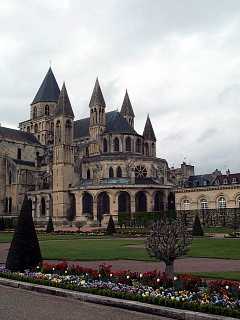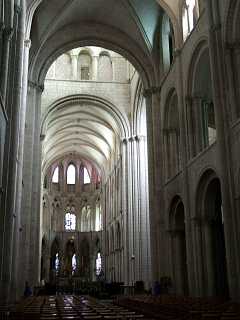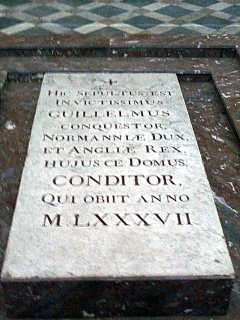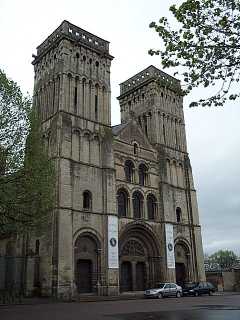The church of L'Abbaye
aux Hommes, Saint Etienne's in Caen, is one of the wonders of
medieval architecture. It is also Claude's favourite building.
Hello Claude!
In 1049 William the Conqueror married the daughter of the Count of Flanders, Matilda. It was a political alliance, ensuring the neutrality of Normany's powerful neighbour during turbulent times. The Pope opposed the marriage, however, and excommunicated William on the grounds that the couple were distant cousins. Both decended from Rollo, the first Duke of Normandy. A talented Italian monk,
Lanfranc, Prior of Le Bec Abbey, pleaded William's cause and
by 1059 had won the Pope's approval for the union. The Pope's
conditions were that William and Matilda should build two abbeys,
one for men and one for women. This is how Caen gained two magnificent
abbeys and a ducal palace (which we did not have time to visit).
Lanfranc rose to become the first Abbot of L'Abbaye aux Hommes
and later Archbishop of Canterbury.
William placed the building
of L'Abbaye aux Hommes and the direction of the new Benedictine
monastery in the hands of Lanfranc. It was dedicated to Saint
Etienne (Stephen), patron saint of Lanfranc's home town of Pavia.
The abbey was consecrated in 1077.
William the Conqueror was buried, as he wished, at L'Abbaye aux Hommes. He had been fatally injured during an attack on Mantes-la-Jolie, when his horse took fright at the flames. William was impaled on the pommel of his saddle and later died in agony at Rouen on September 9, 1087. William de Braose I was present at the King's death. The burial was a fiasco.
Mourners arriving at the abbey heard cries of "fire!"
and rapidly dispersed to fight the devastating flames raging
through Caen. The monks of the abbey continued the ceremony,
but the grave was too narrow to receive the King's coffin. When
the monks attempted to force the coffin into the grave, it burst
open. The stench forced everyone to abandon the building. At
this moment a local resident claimed that the abbey was built
on land owned by his father, for which he had not been paid.
The debt was hurriedly settled and eventually the ill-fated proceedings
to continued.
The tomb of William the
Conqueror was desecrated by Protestants during the Wars of Religion,
and only a single femur survived. The leg bone was placed in
a lead casket and later, in 1742, this was reverently placed
in a vault covered by a marble slab. The slab was smashed only
fifty years later, during the French Revolution. The tomb of
William the Conqueror now seen by visitors dates from 1802.
Queen Matilda's Abbaye aux Dames was completed in June,1066. It was dedicated to the Holy Trinity and generously endowed by ladies of the Norman aristocracy. One of these ladies was Gunnor, William de Braose I's mother, who became a nun of the abbey. Gunnor was most probably buried at La Trinité, as it is called, though no trace of her tomb remains. Regesta Regum Anglo-Normannorum:
The Acta of William I 1066-1087 (edited by David Bates, Oxford,
Clarendon Press, 1998) states:
"Gunnor, the mother of William de Briouze and a nun
of the abbey, gave what she held at Bavent, with the agreement
of Hugh pincerna and Roger de Quilly; she also gave the lands
she held at Rouvres, Cesny-aux-Vignes, Croissanville and Quatre-Puits,
with the agreement of Maurice and his wife Albereda, of whose
fief they were held." Queen Matilda died in 1083
and was certainly buried at La Trinité. A black marble
slab with an affectionate epitaph now marks her grave.
The quarries of Caen provided stone for some of the greatest buildings of medieval Normandy. After the Conquest it was also used in England to build the Tower of London and Westminster Abbey. The Barons de Braose imported large quantities of Caen stone through their ports in the Rape of Bramber. This is a marvellous Eighteenth
Century engraving of La Trinité:
|
© Lynda Denyer, Steyning,
2000 |









